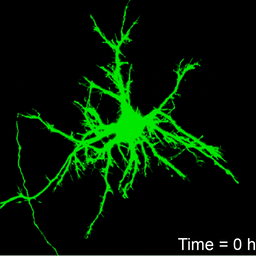Story highlights
A new video reveals what traumatic brain injury looks like on the cellular level
It takes six hours for irreparable damage to develop after a concussion
Scientists hope the findings could lead to new therapies
Scientists have captured in real-time video what happens to a brain cell after experiencing a major concussion-causing impact.
The detailed video was created as part of a new study published in the journal Scientific Reports on Tuesday. It shows a rat’s brain cell – not those of a human – but the research provides the first-ever glimpse of a concussion’s effects on the cellular level at such high resolution and over a 24-hour timeline, said Christian Franck, an assistant professor at Brown University’s School of Engineering and a co-author of the study.
He added that the study findings could hold clues about how to treat human brain trauma victims more quickly and effectively, as the video timeline reveals that irreversible damage begins about six hours after impact.
A new timeline for traumatic brain injury
“I think what was striking to us was within the first four to five hours, you see no difference at all. The cells look healthy, and you think everything is OK,” Franck said.
“Then, about by five to six hours, you see that the structure is changing, and then it starts to change rapidly and degenerate, and it’s dead within a few hours. That was certainly surprising to us,” he added. “It gives us a starting point to understand how much time we have to therapeutically intervene.”

For the study, Franck and his colleagues grew rat brain cells in petri dish cultures with 3-D collagen. Why rats? “We see the exact same pathology in rat neurons as in humans,” Franck said, adding that it’s quite difficult to find human neurons to experiment with.
The researchers put the cultures in a custom-made hydraulic compression device that applied specific concussion-like forces to the cells, and they took real-time micro-images and video of what happened next.
After analyzing the images and video, the researchers discovered that when experiencing forces similar to what’s associated with traumatic brain injury, the delay in the appearance of irreparable damage may be a result of the neuron deteriorating on the inside first.
“The reason why there is a delay is because it’s a chemical process that plays out inside the cell,” Franck said. “There are certain enzymes that, once they become activated – it’s a chemical process inside the cell – they start to chop down the cell from the inside out, and they usually take several hours to become activated. … Once you see the signs on the outside of the cell, it’s potentially too late to do anything about that.”
Two types of brain damage
The researchers also noticed that two types of damage occurred at the cellular level. One type was diffuse axonal injury, which has been identified before in separate studies and is easily spotted by the swelling bulges called “blebs” it causes on neurons – as was shown in the 2015 film “Concussion,” starring Will Smith.
“When we started this work, that’s what we thought we would see. It turns out that when these neurons were impacted slower, that’s not what we saw anymore,” Franck said.
When the neurons were hit with a slower blow, the second type of damage that appeared was what the researchers described as “neurite thinning.”
“Instead of showing these round blebbing features, the cells would just gradually retract all their connections to the surrounding networks and almost sort of silently shut down,” Franck said, describing the thinning.
“The reason that’s significant is because if you were a pathologist or a neuropathologist and looking at a person post-mortem, and you’re only looking for these circular bulges, you may actually under-predict the amount of brain damage that someone suffered,” he said.
Many of the concussion-causing hits that professional athletes in the NFL receive may result in both types of damage, as seen in the new study, Franck said.
Seeking treatment solutions
Franck and his colleagues plan to continue this research to explore possible new treatment options for traumatic brain injury. For instance, an inhaler that sends a blast of cold air to the brain seems promising, as cooling the brain cells can prevent damage from developing, Franck said.
This hypothermia approach has been examined in previous clinical studies, and new research detailing the benefits of cooling brain cells may publish this year, Franck said.
“This is sort of futuristic, but one of the thoughts would be, imagine you have something as big as an asthma inhaler in your hand with two prongs, and if there was concern someone had suffered a concussion, you would inject that, and essentially it would be cold air traveling through the blood vessels in your brain and cool the tissue down just long enough at the right time point,” he said. “This is the sort of thing that we are screening for right now in my lab.”
The new study suggests that using the “inhaler” within six hours after a concussion-causing blow to the head might be that ideal timepoint.
Join the conversation
“Common misconception about concussion is that injury stops immediately after the blow to the head, but the microscopic changes continue to develop over hours, leading to an enlarging zone of injury,” said Dr. Wayne Sebastianelli, a professor of orthopedics at Penn State University and medical director at Penn State Sports Medicine, who was not involved in the new study.
“This study is able to quantify injury based on rate and magnitude of compressive strain,” he added. “Any future treatment modalities intended to minimize injury, as well as the continuation of injury over time, will need to be initiated immediately following the injury.”
















